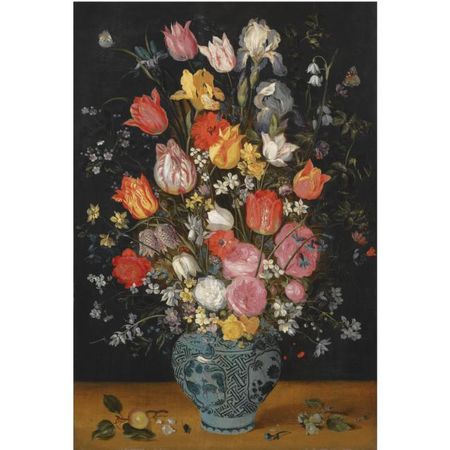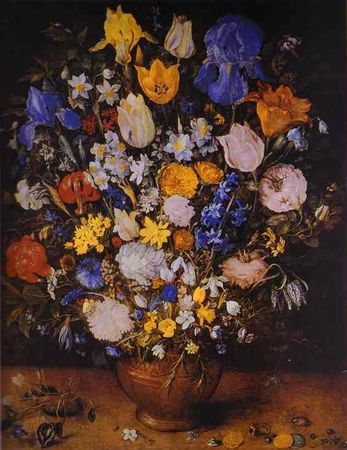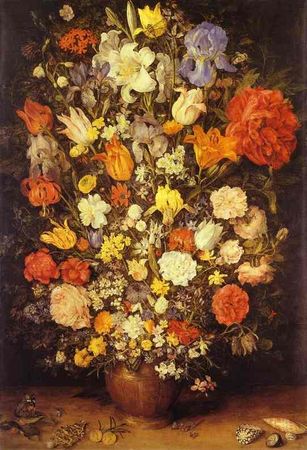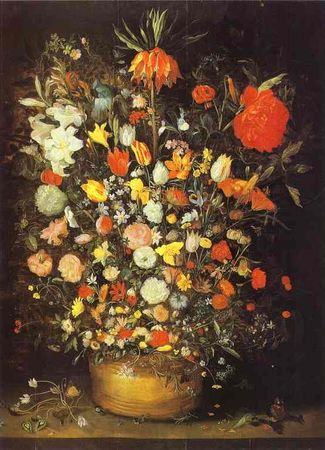Jan Breughel the Younger (Antwerp 1601 - 1678), Still life with tulips, roses, lilies, irises, poppies, hyacinths, ...
Jan Breughel the Younger (Antwerp 1601 - 1678), Still life with tulips, roses, lilies, irises, poppies, hyacinths and other flowers in a blue and white delft porcelain vase
oil on oak panel, 70.4 by 48.2 cm.; 27 3/4 by 19 in. Estimate 600,000—800,000 GBP. Sold 713,250 GBP
PROVENANCE: With J.O. Leegenhoek, Paris, by 1979;
From whom bought by the present owner in 1980.
EXHIBITED: Maastricht, Pictura, 1979, no. 41;
Paris, Grand Palais, Xe Biennale Internationale des Antiquaires, 1980.
NOTE: Jan Brueghel the Younger was born in Antwerp in 1601 and trained in the studio of his father Jan Brueghel the Elder until his departure for Italy in 1622. After the unexpected death of his father in a cholera epidemic of 1625 he returned to Antwerp and took over his father's studio.
Many of Jan Brueghel the Younger's flower pieces are based on his father's prototypes and the present painting is no exception. The composition is largely derived from a still life by Jan Brueghel the Elder in the Kunsthistorische Museum, Vienna, dated by Klaus Ertz to 1608.1 Brueghel the Younger's style in this period, before his departure to Italy, was heavily influenced by his father. So close was the relationship between father and son that a number of these flower still lives have been identified as collaborative pieces with the hand of both master and pupil detectable.2
Although it is possible that the present picture was painted after the Younger's return from Italy, Ertz has convincingly argued that not only the collaborative pieces, but also the modified copies after his father's works, such as the present painting, were painted during the later 1610s and early 1620s.3 Jan Brueghel the Elder painted a number of large flower still lives in wooden tubs and his son did a series of versions after these. Ertz believes that Brueghel the Younger's versions cannot have been painted in the late 1620s as there is no mention of wooden tubs in the studio diaries from this period. It therefore follows that if a large proportion of these modified copies were produced by the Younger before his trip to Italy it seems probable that others, such as the present painting, were also produced at this time. Stylistically this early date would fit with the tighter way the flowers have been painted here. There is a looser, more fluid feel to Brueghel the Younger's brush strokes after his return from Italy.
Despite being based on a prototype designed by his father the present painting has some significant differences in both composition and style which makes it very much the Younger's own work. He has replaced the large iris in the centre with two tulips and changed the arrangement of the acorns on the ledge. The acorns have been moved to the far right and the space they occupied in the Elder's composition is taken by a branch from a crab apple tree. The bottom lip of the Delft vase is gilded in the Elder's composition and not in the Younger's. Stylistically, although still heavily influenced by his father's way of painting, the looser brush strokes in the vase and flower details visible under close examination are much more characteristic of the Younger and a precursor to the further loosening up of his style that was to come.
Sold with photostat certificates of Laurens Bol, dated Dordrecht 20th May 1979 & Marie-Louise Hairs, dated Liège 26th April 1979.
1. See K. Ertz, Jan Brueghel der Ältere (1568-1625), Cologne 1979, pp. 265, 587-8, no. 179.
2. See for example the still life offered London, Sotheby's, 12 December 2002, lot 12.
3. For a discussion of this see K. Ertz. Jan Brueghel der Jungere, Freren 1984, p. 428.
Sotheby's. Old Master Paintings Evening Sale.| 08 Jul 09. London www.sothebys.com
I find another still life of flowerqs from Jan Brughel the Younger :
Jan Brughel the Younger, Still life of tulips, roses, narcissus, forget-me-nots, a carnation and other flowers in a glass vase, resting on a table with a sprig of rosemary and an insect. Oil on copper, 12 x 8 ¼ in. (30.5 x 20.7 cm.) www.colnaghi.co.uk
Others still ilfe by his father in museums. His son is more fluid, in a looser style.
Jan Brueghel the Elder. Bouquet in a Clay Vase. c. 1599-1607. Oil on wood. Kunsthistorisches Museum, Vienna, Austria
Jan Brueghel the Elder. Bouquet. 1606. Oil on copper. Pinacoteca Ambrosiana, Milan, Italy.
Jan Brueghel the Elder. Bouquet. 1606. Oil on wood. Alte Pinakothek, Munich, Germany.
Jan Brueghel the Elder. Bouquet of Flowers. c. 1609-15. Oil on oak. Gemäldegalerie, Berlin, Germany.
Jan Brueghel the Elder. Vase of Flowers with Irises. Oil on panel. Palazzo Pitti, Galleria Palatina, Florence, Italy.
Jan Brueghel the Elder. Vase with Flowers. Oil on wood. Art Museum, Bucharest, Romania

/https%3A%2F%2Fprofilepics.canalblog.com%2Fprofilepics%2F1%2F0%2F100183.jpg)










/http%3A%2F%2Fstorage.canalblog.com%2F34%2F01%2F577050%2F66379918_o.jpg)
/http%3A%2F%2Fstorage.canalblog.com%2F04%2F00%2F119589%2F66268897_p.jpg)
/http%3A%2F%2Fstorage.canalblog.com%2F05%2F37%2F119589%2F66268549_p.jpg)
/http%3A%2F%2Fstorage.canalblog.com%2F86%2F30%2F119589%2F66187962_p.jpg)